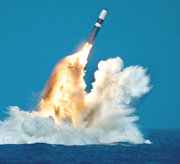Trident missile
|
|
Ohio-class_submarine_launches_Trident_ICBMs_(artist_concept).jpg
The Trident missile is an intercontinental ballistic missile (ICBM) which is armed with nuclear warheads and is launched from submarines (SSBNs), making it a SLBM.
The Trident was built in two variants: the I (C4) UGM-93A and II (D5) UGM-133A. The C4 and D5 designations put the missiles within the 'family' that started in 1960 with Polaris (A1, A2 and A3) and continued with the 1971 Poseidon (C3).
Both Trident versions are three-stage, solid-propellant, inertially guided missiles whose range is increased by an aerospike, a telescoping outward extension that halves frontal drag.
The Trident is carried by 14 active US Ohio class submarines and (with British warheads) four UK Vanguard class submarines.
The launch from the submarine occurs below the ocean surface. The missiles are ejected from their tubes by gas pressure created by a "gas generator," a solid-fuel rocket motor attached to the bottom of the missile tube and exhausting into it. After the missile leaves the tube and rises through the water over the submarine, the first stage motor ignites, the aerospike extends, and the boost stage begins. Within about two minutes, after the third stage motor fires, the missile is traveling faster than 6.1 km/s (20,000 ft/s).
Trident I (C4) was deployed in 1979 and phased out through the 1990s and early 2000s. Trident II (D5) was deployed in 1990; it is planned to be in service past 2020.
Trident I (C4) UGM-93A
The first eight Ohio-class subs were built with the Trident I missiles. Trident Is were also backfitted onto 12 SSBNs of the James Madison and Benjamin Franklin classes, replacing Poseidon missiles.
Trident_C4_first_launch.jpg
Characteristics
- Purpose: strategic nuclear deterrence
- Contractor: Lockheed Martin Space Systems Co., Sunnyvale, Calif.
- Propulsion: three-stage solid-propellant rocket
- Length: 34 ft (10.2 m)
- Weight: 73,000 lb (33,142 kg)
- Diameter: 74 in (1.8 m)
- Range: 7400 km (4,600 statute miles)
- Guidance system: inertial
- Warhead: nuclear multiple independently targetable reentry vehicles (MIRV). Eight W76 (100 kt) warheads (Mark 4).
- Date deployed: 1979
Trident II (D5) UGM-133A
The second variant of the Trident is more sophisticated and can carry a heavier payload. It is accurate enough to be a first strike weapon. All three stages of the Trident II are made of graphite epoxy, making the missile much lighter. The Trident II was the original missile on the British Vanguard and later Ohio SSBNs.
Characteristics
- Purpose: strategic nuclear deterrence
- Contractor: Lockheed Martin Space Systems Co., Sunnyvale, Calif.
- Unit Cost: $300.9 million
- Propulsion: Three-stage solid-propellant rocket
- Length: 44 ft (13.41 m)
- Weight: 130,000 lb (58,500 kg)
- Diameter: 83 in (2.11 m)
- Range: greater than 7400 km (4,600 statute miles)
- Guidance system: inertial
- Warhead: nuclear MIRV. Up to 8 W88 (475 kt) warheads (Mark 5) or 8 W76 (100 kt) warheads (Mark 4).
- Date deployed: 1990

